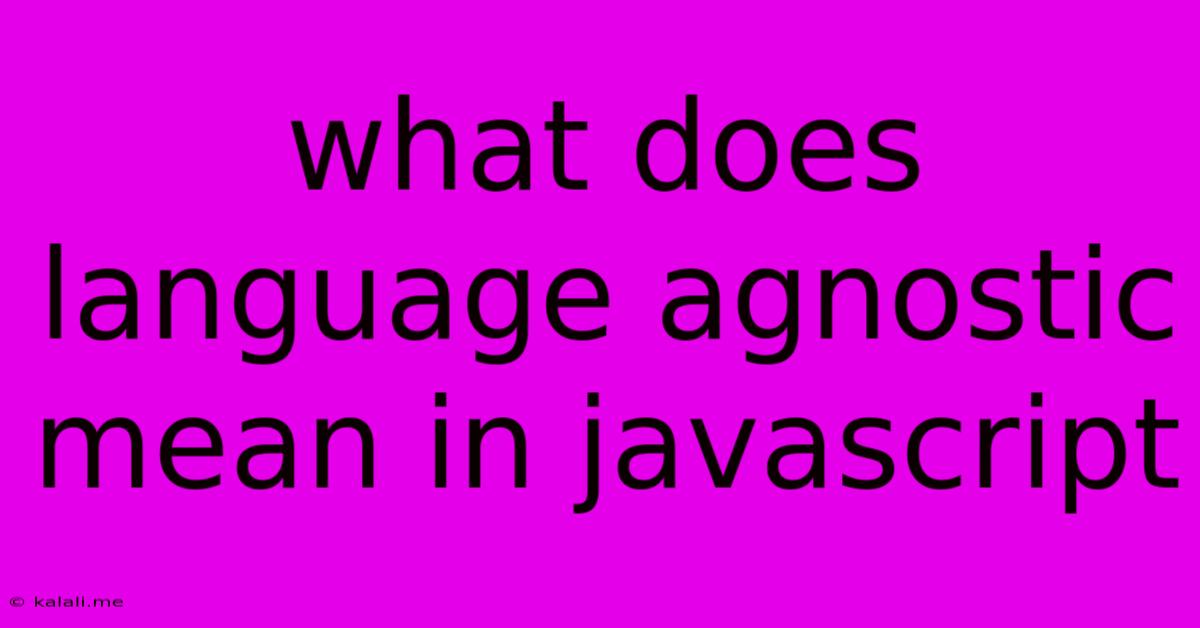What Does Language Agnostic Mean In Javascript
Kalali
Jun 07, 2025 · 3 min read

Table of Contents
What Does "Language Agnostic" Mean in JavaScript? Unlocking the Power of Abstraction
JavaScript, renowned for its versatility and ubiquity in web development, often gets associated with terms like "language agnostic." But what exactly does this mean? This article will delve into the concept of language agnosticism in JavaScript, exploring its implications and how it contributes to the language's power and flexibility. Understanding this will help you write more efficient, maintainable, and scalable JavaScript code.
Language agnosticism in JavaScript primarily refers to its ability to interact with and utilize data and functionality from various sources and programming languages without being directly tied to their specific syntax or implementation details. This is achieved through several key mechanisms.
Abstraction Layers: The Key to Language Agnosticism
JavaScript's strength lies in its capacity for abstraction. Instead of directly interacting with the underlying details of different data formats or systems, JavaScript uses intermediary layers that handle the complexities. This abstraction allows developers to work with data in a consistent manner regardless of its origin.
Think of it like this: you use a universal remote to control your TV, DVD player, and sound system. You don't need to understand the individual inner workings of each device; the remote provides an abstract interface. Similarly, JavaScript provides abstractions for interacting with diverse data sources and APIs.
JSON: The Universal Data Format
JSON (JavaScript Object Notation) plays a crucial role in JavaScript's language-agnostic capabilities. It's a lightweight data-interchange format that's easily parsed and manipulated by JavaScript. Because many programming languages can easily generate and consume JSON, it acts as a bridge, allowing seamless communication between JavaScript and other systems built using different languages.
For example, a backend system written in Python might send data to a JavaScript frontend as a JSON string. JavaScript can then easily parse this string, access the data, and utilize it within the application. This process is independent of the Python backend's implementation.
APIs and Libraries: Extending JavaScript's Reach
APIs (Application Programming Interfaces) provide a set of rules and specifications for interacting with external services or systems. JavaScript leverages APIs extensively to access data from different sources, such as databases, cloud services, or other web applications. These APIs often abstract away the complexities of the underlying systems, allowing JavaScript to interact with them in a consistent manner.
Numerous JavaScript libraries and frameworks further enhance this language-agnostic nature. Libraries like Axios simplify making HTTP requests to retrieve data from various APIs regardless of their implementation language. Frameworks such as React or Angular offer tools for building complex user interfaces while abstracting away the details of DOM manipulation and data binding.
Database Interactions: Beyond JavaScript's Scope
While JavaScript can manipulate data received from various sources, it typically doesn't directly interact with databases. This task usually falls to backend servers written in languages like Python, Node.js (which uses JavaScript on the server-side), Java, PHP, or Ruby. JavaScript primarily focuses on the frontend, receiving processed data from these backend systems via APIs. Therefore, database interaction is often indirectly language-agnostic through the use of intermediary APIs.
Implications for Developers
The language-agnostic aspect of JavaScript offers several significant advantages to developers:
- Increased Reusability: Code written to handle JSON data or interact with specific API formats can be reused across multiple projects regardless of the backend technology.
- Improved Interoperability: JavaScript can easily integrate with systems developed in other programming languages, fostering collaboration and efficient development workflows.
- Enhanced Flexibility: Developers can choose the most suitable tools and technologies for different parts of a project without being constrained by JavaScript's limitations.
- Simplified Development: Abstractions provided by APIs and libraries simplify development, allowing developers to focus on the application logic rather than low-level details.
In conclusion, "language agnostic" in the context of JavaScript signifies its capability to interact effectively with various programming languages and data formats through abstraction layers, standardized formats like JSON, and powerful APIs and libraries. This characteristic is a cornerstone of JavaScript's widespread adoption and its versatility in building modern, scalable, and interconnected web applications.
Latest Posts
Latest Posts
-
Can You Do Nikah Without Parents
Jun 07, 2025
-
Does French Press Work On Induction Strove
Jun 07, 2025
-
Be Ye Perfect As I Am Perfect
Jun 07, 2025
-
Should You Have A Range For Desired Salary
Jun 07, 2025
-
Android Disable Long Press On Home Screen
Jun 07, 2025
Related Post
Thank you for visiting our website which covers about What Does Language Agnostic Mean In Javascript . We hope the information provided has been useful to you. Feel free to contact us if you have any questions or need further assistance. See you next time and don't miss to bookmark.